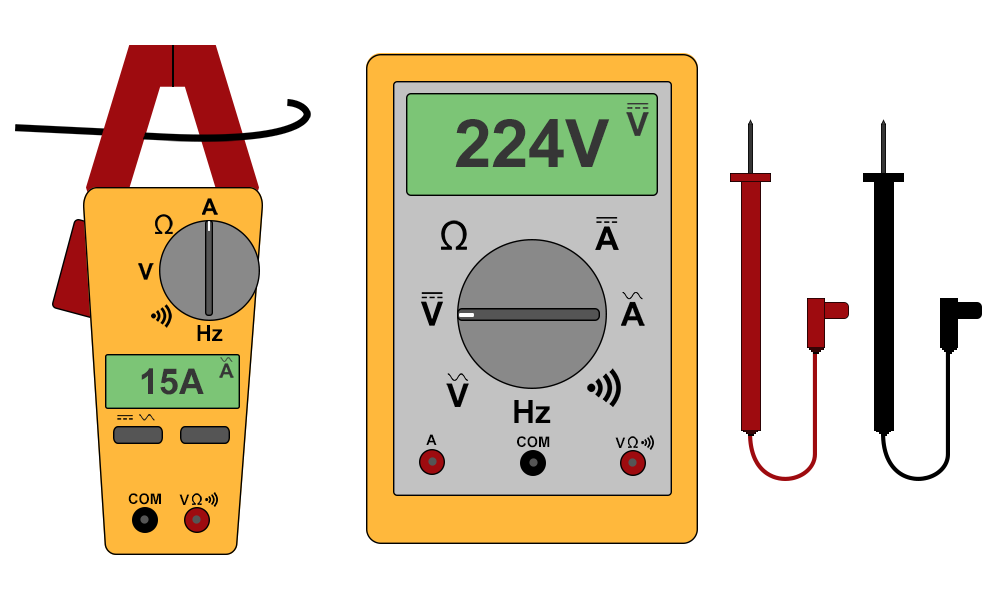Multimeters
Multimeters are the most important tool one has when working with electricity. A multimeter allows you to measure all of the important characteristics of a circuit or electrical system, which enables you to work safely and verify if a circuit is working correctly. There are many different types of multimeters that offer a variety of different functions. They range in cost dramatically as well. All multimeters, even cheap ones, should be able to perform the basic measurements that are required to do electrical work: voltage, current, resistance, conductivity, and frequency. That being said, it is important to make sure that the multimeter you are using is rated for use with the highest potential voltage and current that you intend to measure. If a multimeter is not rated to function under the conditions of use, it could destroy the multimeter and potentially cause severe harm. Multimeters are classified into various categories that inform users about their ability to handle excess voltages and current. These ratings go from the lowest rating being Category I (for use with small electronics with limited current and voltage sources) to Category IV (for use at the connection to the utility grid and all outdoor conductors).[1] For small off-grid PV systems at least a Cat II - 600 V multimeter is recommended and should be fairly cheap.
Contents
Functions of a multimeter
Voltage
Any multimeter that is to be used have the ability to measure both DC and AC. It is important to understand the type of current that is going to be measured, as using the wrong setting can lead to a false reading which can be misleading and dangerous. A multimeter will have a dial that allows the user to select between AC and DC, which will be identified using the common symbols seen below. When working with a PV system, voltage is typically measured for the following reasons:
- To check if there is voltage in a circuit before beginning to work.
- To test the performance of a component in a PV system. Is the voltage within an acceptable range given the conditions? The battery should be fully charged, what is its voltage?
- To identify where a problem is in a system by troubleshooting by testing various circuits and components in the system such as the battery, PV source, inverter, outlets, or light sockets.
Current
Not all multimeters can take AC and DC current measurements, but for work with PV systems it is important to find one that does. There are two different ways to measure current with a multimeter, this is explored in the section - types of multimeters. When working with a PV system, current measurements are typically taken for teh following reasons:
- To check if there is any current flowing in a circuit before beginning to work.
- To understand how the PV module or array is functioning. How much current is it producing under the conditions?
- To understand power consumption for a system or various loads within a system.
- To understand the flow of electricity. If the system is feeding a heavy load, what circuit or device is using the energy?
Resistance
All components of an electrical system have some amount of internal resistance, but also resistance relative to other components of the system. When working with a PV system, resistance measurements are typically taken for the following reasons:
- To ensure that a connection made in the system has a low enough resistance to function properly. High resistance connections can create heat and fires.
- To ensure that there is a high resistance between the earth/ground and components of the system that should not have a connection of any kind to the ground like an ungrounded conductor. A low resistance connection in this case would signify a ground fault.
Safety: Resistance measurements cannot be taken on circuits that have voltage or that have current flowing on them. Do not attempt it as it is can lead to injury or death.
Conductivity
A conductivity check is a simplified resistance measurement. If a connection has a sufficiently low resistance - below a certain value that is set inside the multimeter - then the multimeter will emit a sound. If there is a high resistance between the two points of measurement, the multimeter will do nothing. Some common checks that are done with a conductivity test:
- Check whether a breaker, fuse or switch is working. A fuse should have conductivity if it is still good. If it fails a conductivity test then it needs to be replaced and the reason for its failure investigated.
- To test quickly whether a connection to a busbar or between two wires in a circuit was done properly.
- To test whether a wire or system component is a part of a circuit. Often times wires are not properly identified, but a quick conductivity can often identify where that wire leads and to what it is connected.
Safety: Conductivity checks cannot be taken on circuits that have voltage or that have current flowing on them. Do not attempt it.
Frequency
Frequency is a property of AC current. Inverters in an off-grid system should be operating within a specific frequency range, a frequency check can tell us that they are outside of this range and that there is a problem. AC frequency being out of this acceptable range can cause issues with appliances.
Types of multimeters
Traditional handheld multimeter
These are the most common and economical multimeters on the market. For a low price they can perform many different functions and, if it is a decent brand, should be fairly accurate. These multimeters rely on probes to take all of measurements. These types of multimeters have at least three different ports and the probes must be rearranged depending upon the measurement. Taking voltage and current measurements - as seen in the diagram - always require the moving of the red probe to a different port as these two measurements use different circuits. As the multimeter measures current using probes, any current that is measured must pass through it, which is often limited to 10-15 A. There is an internal fuse that will be destroyed if one attempts to pass current in excess of its rated value through the multimeter. This means that one cannot take current measurements of circuits for which the maximum amount of current is not known. Nor can one take measurements of a source that can supply high amounts of current - like an outlet or a battery - as the multimeter simply provides a low resistance path for the current to pass through. If measuring currents near or in excess of 10A may be required, then it is necessary to get a clamp meter.
These meters come in two types:
Manual-ranging
This type of multimeter requires the user to select the maximum voltage, current, or resistance in order to take a measurement. If too high of a range is used, it will lead to inaccurate measurements. If too low of a range is used, the multimeter will give an error. The cheapest multimeters are manual-ranging. For example:
- Example 1: You would like to take a voltage measurement of a circuit that you suspect to be 220 V AC. Your options on the multimeter are 120 V AC, 250 V AC, 500 V AC. What is the proper range for taking this measurement?
- Answer: 250 V AC. The 120 V AC setting will produce an error. The 500 V AC setting may produce an inaccurate reading. The 250 V AC setting will be able to provide the most accurate measurement.
One technique that works with a manual ranging multimeter, is to start at the highest range, get a measurement and then work your way down to the lowest range capable of measuring a value in that range until there is an error.
Auto-ranging
This type of multimeter does the work of selecting the range itself and can save time for the user. For a slightly higher price than the price of manual ranging multimeter, it is possible purchase one that is auto-ranging. The additional cost is worth it if you will be using the meter frequently.
Clamp meters
Clamp meters are auto-ranging and share all of the basic functions of a traditional handheld multimeter, but they enable current measurements above 10 A to a certain limit, typically around 300-400 A. The multimeter performs current measurements by measuring the current that is flowing in a wire based upon the electro-magnetic field that it generates. To take a measurement one simply passes one wire of a circuit through the jaws of the clamp, which can easily be opened and closed by a button the side. It is important to only pass one wire of a circuit through the clamp because if both wires are passed through the currents will cancel out.
A clamp meter is extremely useful, easy to use and significantly safer than a traditional handheld multimeter. The meters do cost slightly more, but the additional cost is is worth it if you will frequently take current measurements.
Safely taking measurements with a multimeter
Like any tool, if a person doesn't know how to use a multimeter correclt it can be at best useless and at worst it can be dangerous. There are a few basic questions that should be asked and steps that should be taken when performing any measurements with a multimeter.
- What type of current are you working with?
- What is maximum amount of voltage and current that the circuit you want to measure could supply?
- Do you have the proper training and tools to work on this equipment?
- What do you want to measure and why?
- What value should you get if everything is as it should be?
- Configure the multimeter and check the voltage of the circuit before performing any other measurements to check if it is live.
- Set your multimeter to the right setting for any other measurement that is necessary.
- Carefully take the measurement and then check it against the anticipated value that you came up with in Step 5.
Notes/references
- ↑ Fluke Application Note on multimeter categories https://content.fluke.com/promotions/promo-dmm/0518-dmm-campaign/dmm/fluke_dmm-chfr/files/safetyguidelines.pdf







